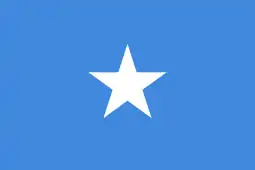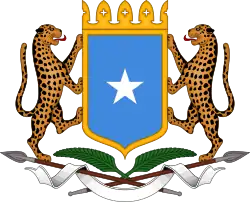Interim Government of Somalia
The Interim Government of Somalia, led by Ali Mahdi Muhammad, was established immediately after the collapse of the Somali Democratic Republic. From November 1991 to 1995, Ali Mahdi Muhammad enjoyed recognition as President in the international community following the 1991 Djibouti conference held between 15 and 21 July 1991, Ali Mahdi was elected interim President of Somalia for a period of two years, but because of the legitimacy conferred on Ali Mahdi by the Djibouti conference, his government was recognized by several countries, including Djibouti, Egypt, Italy, and Saudi Arabia.[1]
Interim Government of the Somali Republic | |||||||||
|---|---|---|---|---|---|---|---|---|---|
| 1991–1997 | |||||||||
.svg.png.webp) | |||||||||
| Capital | Mogadishu | ||||||||
| Common languages | Somali · Arabic | ||||||||
| Religion | Islam | ||||||||
| Government | Provisional government | ||||||||
| President | |||||||||
| Historical era | Somali Civil War | ||||||||
• A multi-phased international conference on Somalia | January 1991 | ||||||||
• Disestablished | January 1997 | ||||||||
| ISO 3166 code | SO | ||||||||
| |||||||||
However, he was not able to exert his authority beyond certain parts of the capital. Power was instead vied with other faction leaders in the southern half of the country and with autonomous subnational entities in the north.[2] The competition for influence and resources between Muhammad and Mohamed Farrah Aidid continued on through the 1992–95 UN missions to Somalia (UNOSOM I, UNOSOM II, and UNITAF), until Aidid's eventual death in 1996.
References
- "Harbinger of a new world order?". library.ubc.ca. Retrieved 2014-03-05.
- "Somalia: Some key actors in the transitional process". IRIN. 2005-05-06. Retrieved 2007-02-07.

